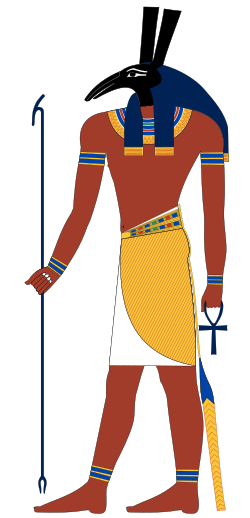Set (dewa)
From Wikipedia, the free encyclopedia
Remove ads
Set (/sɛt/; bacaan Egiptologi: Sutekh - swtẖ ~ stẖ[a] atau Yunani: Seth /sɛθ/) ialah dewa padang pasir, ribut, kekacauan, keganasan dan orang asing dalam agama Mesir purba.[6]:269 Dalam bahasa Yunani Purba, Set dinamakan sebagai Sēth (Σήθ). Set mempunyai satu peranan positif yang mana dia menemani Ra dalam bahteranya untuk menghalau Apep, ular Kekacauan.[6]:269 Set berperanan penting sebagai seorang pahlawan yang menamatkan konflik.[6] :269 Dia raja Tanah Merah (gurun), mengimbangi peranan Horus sebagai raja Tanah Hitam (tanah subur).[6]:269
Dalam mitos Osiris, mitos Mesir yang paling penting, Set dikisahkan sebagai perampas takhta yang membunuh dan mengerat-ngerat saudaranya sendiri, Osiris. Isteri/kakak Osiris, Isis, menyusun semula mayatnya dan membangkitkan abang/suaminya yang sudah mati dengan bantuan dewi Nephthys. Kebangkitannya cukup lama untuk mereka mengandungkan anak dan pewaris Osiris, Horus. Horus membalas dendam terhadap Set dan banyak mitos Mesir purba menceritakan konflik mereka.[7]
Dalam astronomi Mesir purba, Set biasanya dikaitkan dengan planet Utarid.
Oleh sebab Set berkaitan dengan kawasan barat Nil iaitu Sahara, dia kadangkala dikaitkan dengan dewa yang lebih rendah, Ha, dewa padang pasir, iaitu dewa yang digambarkan sebagai seorang lelaki dengan determinatif gurun di kepalanya.
Remove ads
Family

Set ialah anak Geb, Bumi, dan Nut, Langit; adik-beradiknya Osiris, Isis dan Nephthys. Dia berkahwin dengan Nephthys dan ayah kepada Anubis dan Wepwawet. Dalam beberapa kisah, dia mempunyai hubungan dengan dewi asing Anat dan Astarte.[6]:270 Daripada hubungan tersebut dikatakan lahirlah dewa buaya bernama Maga.[8]
Asal usul nama
Maksud nama Set tidak diketahui tetapi ia mungkin asalnya disebut *sūtiẖ [ˈsuw.tixʲ] berdasarkan ejaan namanya dalam hieroglif Mesir sebagai stẖ dan swtẖ.[9] Ejaan Mesir Akhir stš mencerminkan pelelangitan ẖ manakala kehilangan konsonan akhir direkodkan dalam ejaan seperti swtj.[10] Bentuk namanya dalam bahasa Qibti, ⲥⲏⲧ Sēt, menjadi asas sebutan bahasa Inggeris dan akhirnya dipinjamkan ke bahasa Melayu.[9][11]
Remove ads
Binatang Set

Dalam seni, Set biasanya digambarkan sebagai makhluk ganjil yang pakar peradaban Mesir gelar sebagai "haiwan atau binatang Set", binatang yang tidak menyerupai mana-mana haiwan yang diketahui. Akan tetapi, ia menyerupai babi tanah, anjing liar Afrika, keldai, dubuk, jakal, khinzir, antelop, zirafah, okapi, saluki atau rubah fanak. Haiwan itu mempunyai muncung yang melengkung ke bawah; telinga panjang berbentuk segi tiga; ekor nipis bercabang dengan jumbai bulu yang tumbuh dalam bentuk anak panah terbalik; dan badan anjing yang kurus. Kadangkala, Set digambarkan sebagai manusia dengan kepala yang tersendiri. Beberapa ahli kaji Mesir awal berpendapat ia imej stailistik zirafah, kerana "tanduk" atas rata yang besar sepadan dengan osikon zirafah. Namun, orang Mesir sendiri menggunakan rupa zirafah yang berbeza dengan haiwan Set. Semasa Zaman Akhir, Set biasanya keldai atau sebagai lelaki dengan kepala keldai,[12] dan dalam Kitab Faiyum, Set mempunyai kepala flamingo.[13]
Gambaran terawal haiwan Set berasal dari sebuah makam dari budaya Amrat ("Naqada I") Mesir prasejarah (3790–3500 SM), namun ia belum disahkan. Jika ini diabaikan, haiwan Set terawal muncul pada hulu parang istiadat Scorpion II, pemerintah fasa Naqada III. Kepala dan ekor bercabang haiwan Set jelas terdapat pada cokmarnya.[14]
Nota
- Juga dialih huruf kepada Sheth, Setesh, Sutekh, Seteh, Setekh, atau Suty. Sutekh muncul sebagai dewa orang Het dalam pengisytiharan perjanjian antara raja-raja Het dan Ramses II selepas pertempuran Qadesh. Mungkin Seteh ialah leksi (sebutan) dewa yang dipuja orang Het, "Kheta", selepas itu diasimilasikan dengan Seth Afro-Asiatik tempatan.[4][5]
Rujukan
Sumber
Pautan luar
Wikiwand - on
Seamless Wikipedia browsing. On steroids.
Remove ads

